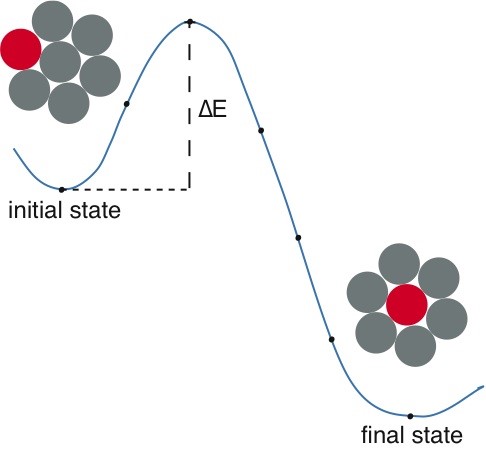I turned towards energy devices which are real hopes for the future of humankind. I have chosen to work on energy storage materials especially materials involved in lithium-ion battery. The literature review motivated me to investigate olivine phosphate as good choice to work with as Li ion battery cathode material. I faced problems to optimize its structure and understood its complex structure. In addition to study the electronic properties of the cathode material, I employed Molecular dynamics simulations to calculate the power density of the electrode. In addition to this, I utilized Nudged Elastic Band Method to find the hooping barrier and diffusivity for the desired electrode material. The calculated diffusion barrier for hopping of Li ion in LiFePO4 is sketched in figure

I planned to modify the LiFePO4 material with RE metals Gd & Ce as LiGdPO4 or LiCePO4 to analyze its power density and stability. I thought that Gd will be good choice to facilitate the motion of Li ion in the crystal because Li, Gd belongs to rare earth series and these are well known because of their huge sizes and immense columbic potentials so lattice expansion in the GdO6 octahedra is expected. The high electronegativity is also expected to increase the overall stability of the material. In order to understand the mechanism involved, I performed complete analysis of electronic and magnetic properties of the structure and calculated the steric interaction and electron localization function (ELF) analysis. I also calculated the intercalation potential of the material. On the basis of our experience on such systems, it is found that RE could be a good choice for electrode material however the lattice expansion could affect its stability that could be overcome by co-doping with TM metals like Fe, Co and Zn. The story is not yet completed and the work is in progress in our group.
After using several tools to theoretically investigate the properties of materials, I came to know that Nudged Elastic Band (NEB) method is highly resourceful tool to study the physics and chemistry of materials since it helps to calculate the rate of reactions, transition state, and reaction barriers etc. The application of this technique helps studying the potential energy surfaces, stages of reaction by monitoring the reaction parameters in very simple and efficient way. This is advance form of basic, chain of states or method of images in which different intermediate images (structures of intermediate reaction determine the minimum energy path between two predetermined minimized energy states such as shown in figure.

In this technique we use different images to guess a reaction path to guess the minimum energy path and transition state (mostly the exited state) of a reaction. These images are connected by small spring connector that gives the nudging effect to the reaction states and lead them to the next reaction state by following the minimum energy path. This is not first principles based iterative minimization process that gives a completely downhill movement energy path. Since it requires optimization of different (desired) images so it is computationally expensive method. However, understanding and implementation of this method gives a useful skill to explore variety of properties. The most common problem arises when transit species come very close to any nearby atom that could excite the state above the limits and stops the calculation. This could be overcome by accurately designing the intermediate image files. We could also accelerate the calculation by freezing the atoms that don’t have negligible effect on the transiting species and this is successful in large supercell which saves the computational cost effectively. However, one could face more elegantly the problem of atoms come too close while implementing this approximation.
We can save our time while calculating the NEB at basic quality first and then extending it to the high quality in order to determine the accurate rate of a reaction. The first run will show if the calculation path we adopt is possible or not also it will initialize the system to optimize faster. There is no short cut to determine the energy barrier otherwise.
